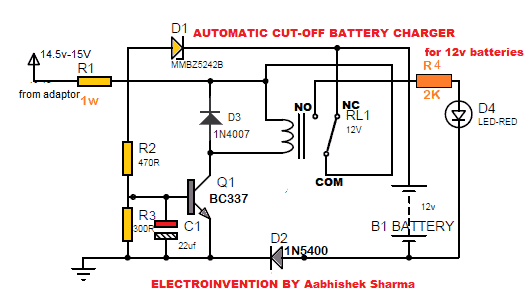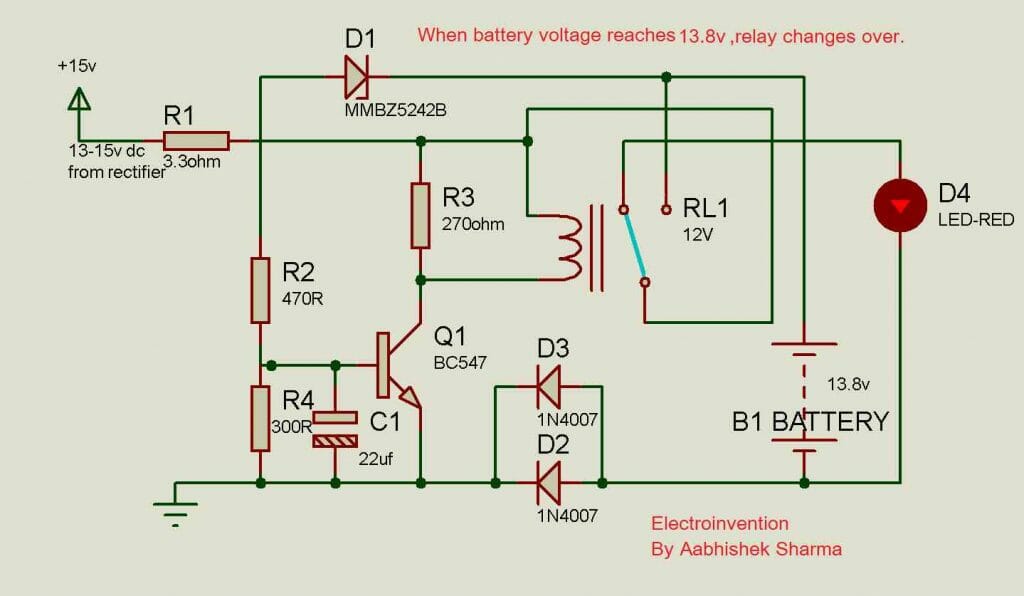Hello Engineers, Today I am going to discuss an automatic battery charger circuit designed by me.12V lead-acid batteries are being used in today’s world in a large number of applications/devices too. They can be used in inverters, computer UPS, kids automotive rechargeable buggy cars, Automotives(transportation vehicles), engineering projects, etc. Some of those devices have an inbuilt auto-cutoff battery charging system but for use of those 12V lead-acid or SLA or any kind of 12V batteries separately for hobby purposes or for other separate use, requires a separate charger. While designing a separate charger we need to design a safe and automated charging system and cut-off after battery charges. So, let’s begin with our Automatic battery charger Circuit | auto cut-off battery charger. Or, Smart Automatic battery charger Circuit for 12v Lead-acid battery.
So, the circuit in this article monitors the charging of the battery and takes the input from the charger or bridge rectifier and charges the battery, when the battery voltage reaches a certain level it cuts off the charger and stops the battery charging. Let’s begin.
Automatic battery charger Circuit Diagram for 12v

The rectifier /battery chager for power input

If in some cases, after the rectification and filtration the output voltage can have an increment of about 2v more due to capacitor. If it does, then I prefer to use the LM7815 voltage regulator circuit ( 1amps limit) or LM338 High power variable PSU circuit( 2- 5Amps) ( both are explained on the site.) I still recommend using either 15v DC ready-made adaptor or use the LM7815 Regulator circuit or LM338 high power variable PSU circuit.
Materials
- Q1 Transistor Bc547 or bc337(337 will be preferred more)-1pcs
- C1 Capacitor 22uf 25volts -1pcs
- R2 Resistor 470R – 1pcs
- R3 300R -1ps
- RL1 Relay 12V
- R1 3.3 Ohm or 3R3, 1 Watt or 2 watts -1pcs
- D3 1N4007
- R4 2K-5K
- D1 BZ5242B or any 12v 1w Zener diode
- D2 1N5400-1pcs
- D4 LED-RED
- Transformer 0-15V,2Amp-5Amp ( for battery charging rectifier. BUT I RECOMMEND 15V DC 1A OR 2 A DC ADAPTOR SO THAT IT HAS REGULATED VOLTAGE ) or use LM338 Variable PSU Circuit, 2A-5A for bigger batteries.
- Bridge rectifier diodes 1n5400-4pcs
- Battery suitable (lead-acid,SMF,SLA,GEL CELL,AUTOMOTIVE) 12v , 1.2ah-20 ah
The circuit diagram for charging control and auto-cut as well as a rectifier for power input with a material list is above. I prefer to use a 15v DC 1A or 2A adaptor for perfect voltage and current regulation. Or I prefer to use the LM7815 voltage regulator circuit ( 1amps limit) or LM338 High power variable PSU circuit( 2- 5Amps) ( both are explained on the site.)
Working of the circuit
- In the above circuit, whole charging is governed by BC337 transistor and relay RL1 acts as the changeover.
- During charging the circuits takes input via a charger /bridge rectifier charger circuit shown above and through the relay’s COM and NC, the power is directly connected to the battery.
- After the battery reaches a certain level the transistor bc547 id tuned ON and it drives a relay which in turn changes the COM pin’s link from NC to NO which is connected to the red color LED that will start glowing after relay changeover, indicating the battery charging completion.
- I have set this circuit’s calibration at 13.8v last voltage. When the battery reaches 13.7 or 13.8v then suddenly charging stops and red color led glows as an indication for full charging.
- Below is the image showing how the circuit cuts off the charging when the battery reaches 13.7 or 13.8v.
when the battery is more than 13.7v

The above image during the simulation when the battery voltage reaches above 13.7 volts i.e when the battery tries to reach 13.8v suddenly transistor BC337 turns ON the relay and charging stops and red led starts getting power. This is how the circuit works. I hope this circuit might be very useful to you guys and you liked it.
The adequate amount of current and charging voltage should be there to perfectly charge a battery under safety. Charging modes also matter like constant-current charge, topping charge and float charge.
For charging a 12v lead-acid battery, the adequate charge voltage must be 14v-14.7v dc and charging cut-off voltage can be from 13.7v – 14v dc. The same is for an inverter battery.
For the charging current specs charging current should be 10% of the Ah rating of the battery. So, for example, to charge a 12v 10ah battery you need a charger of 14v and 1Amp as an adequate and calculated rating charger. But the practical condition differs from the bookish info. So, you can go up to 14v and 1.5A charger for adequate and safe charging that may charge your battery in 5.7 hours approx.
Note: An improvement to this circuit can be made: https://www.electroinvention.co.in/automatic-battery-charger-auto-cutoff#comment-1874 By Mr. V.Sambath Kumar
If you liked it or if you have any questions then please do comment down and let me know. Cheers and the next tutorial is coming soon on the site.


What are the functions of (R3) 270 ohms..
Hello Sujoy, R3 isn’t 270 ohms. it’s 300ohms. Both R3 and R2 work as a voltage divider, you can use a 1k Potentiometer instead to eliminate both R2 and r3.
Actually I’m talking about the last circuit diagram, where R1=3.3 ohms, R2 =470 ohms, R3=270 ohms, R4=300 ohms. R3 (270 ohms) is connected with collector of BC547. Can you explain, why 270 ohms is used instead of 1N4007 diode?
Thank You
Ah, the last circuit is just to show that the relay changeover and Red LED is glowing. The last circuit is actually not correct, I forgot to update that it just shows relay changeover that’s it.
The first circuit is the correct one. The last one is just for visuals.
What is the function of 27ohms resistor connected parallel to 15V supply? after rectification and filtering, the DC voltage will be nearly 20V. This 27ohm resistor alone will draw around 700mA. Also, without proper current limiting, this high voltage charging will damage the battery.
hello, Anil Kumar. The function of the 27r resistor is just for the relay coil discharge and protection, and Yes it’s drawing that amount but it’s not active during the battery charging, so it won’t affect any battery charging performance. It’s only when transistor Q1 turns the relay on for battery charger cut-off.
2nd point, I recommended that to use a 15v DC 1A or 2A adapter in the article to charge the battery which has proper voltage and current regulation of course. Now I am adding that line to material list also to make it easy to catch the vision and also clearing those prewritten lines.
You are saying that if someone uses a handmade rectifier circuit then after rectification and filtration, the voltage will bounce nearly 20v, but I don’t think or have, not seen it. If in some cases, it does, then it’s common sense to use LM7815 voltage regulator or LM338 High power variable PSU circuit( both are explained on the site.) I still recommend using either 15v DC ready-made adaptor or use the LM7815 Regulator circuit or LM3338 high power variable PSU circuit. Also adding some extra lines to the article.
Sir, can I replace 3.3 ohms with other resistors? Like 2.2 ohms, 4.7ohms, 5.6 ohms, 10 ohms (1 or 2 watt). ohms is not available in our local market.
Yes, 2.2 Ohms 1 watt is ok. Or, better will be, you can use 2 1N4007 in series with the relay before the power input to that relay. And do the COM connection directly to the inpt supply then.
Thank you sir.
goodluck
Hi, pls I need auto cutoff for 24v 150ah for inverter
Hi ZUREDU, Thanks for visiting, This circuit isn’t suitable for 24v 150ah battery, You can use any 24v 5A or 10a SMPS circuit to charge the battery or the circuit explained in this article https://homemade-circuits.com/wp-content/uploads/2011/12/high2Bcurrent2Bbattery2Bcharegr2Bcircuit.png . It’s my kind of teacher’s website.
Hi
I want to know how did you fix 13.7 volt if we want to hold it to 14 or 15 volts how could we deal it ,which component we use it plz explain and guide
Hi Waheed, Thanks for visiting. I have set the value to 13.7v by adjusting the values of R2 & R4. You can also use some simulation software like proteus before making to adjust the values. You can use a 10K POT if you don’t have simulation software.
Nice one
With better Explanations
Hello Daniel, thanks for visiting.
Can I get many Circuit diagrams from this site???
Yes sure, thanks for visiting. I am going to upload many other intresting circuits and projects.
Okay. Thanks
Actually I need a project HOME AUTOMATION USING IOT OR ARDUINO PROGRAMMING.
Hello Daniel, thanks for visiting. Sure I will upload them when I get time.
hi, sir nice circuit, how can I be use 9-0-9v tansformer if iam not getting d 15v transformer.(tell me way to conect output wires ).
Hello Creta , thanks for visiting again, if you find it hard to get the 0-15v transformer I prefer you to use the LM7815 voltage regulator which is a 15v 1A voltage regulator and it’s suitable for batteries up to 10ah and will charge 10ah in 8 hours approx.
Another good option is that you use the LM338 variable voltage regulator Power supply which can go up to 2A – 5A which is good for bigger batteries.
Remember, Battery charging current should be 1/10th of the Ah value of the battery.
This can be done if you cant arrange 0-15v 2A transformer but if you can arrange one,then that would be better.
OK sir thank you so much for your reply.